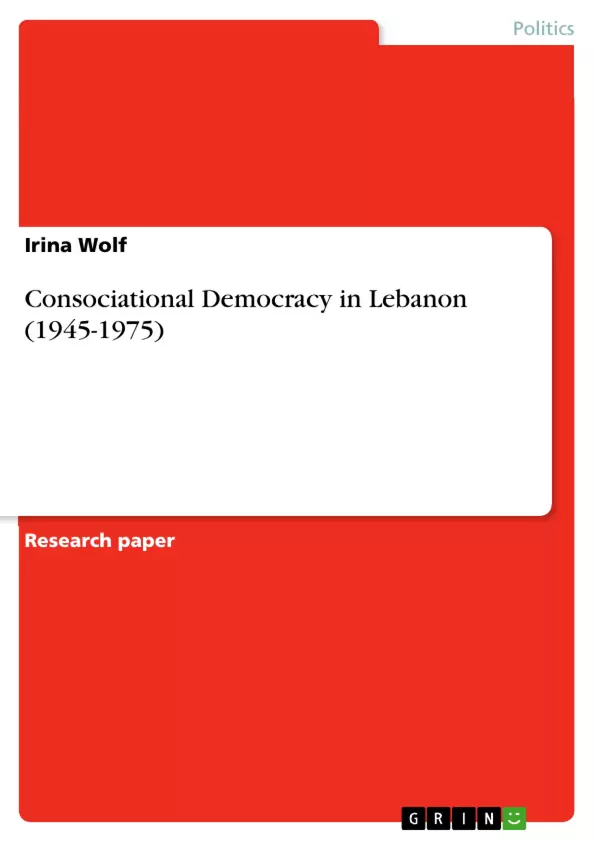Lebanon is a unique country of the Middle East. It is very ancient and it is located in such a way that once was called “the gate of the Middle East” . During centuries numerous conquerors invaded Lebanon to gain strategic leverage in regional dominance. There are three major religious groups - Maronites, Druzes, and Shiites – living in the country, of which Maronites are part of a Christian mainstream and Druzes and Shiites are of a Muslim one. Granting independence to Lebanon, the French wanted to secure the position of the Christians and not let it “be absorbed into a Syrian Muslim state.” Lebanon traditionally considered itself the only Christian country in the Arab world and was always backed up by France. The history of Lebanon was filled with religious and violent conflicts, which were inflamed by surrounding nations and often resolved by major powers. The antipathy among Maronites, Druzes, and Shiites was so strong that the solution had to be found urgently.
To avoid conflicts among the different subcultures the French established the consociational democracy. Lebanon didn’t completely meet all the core principles of the consociational democracy and it consequently led to the civil war of 1975, to sectarian unrest and struggles for political and economic power. However, the results of the consociational democracy were the peace in Lebanon for thirty years, and the economic prosperity.
Inhaltsverzeichnis (Table of Contents)
- Introduction
- The history of an establishment of Lebanese political system
- Consociational Democracy. Why did it work in Lebanon and why it failed?
- Conclusion
Zielsetzung und Themenschwerpunkte (Objectives and Key Themes)
This paper examines the implementation of consociational democracy in Lebanon from 1945 to 1975. It aims to analyze the factors that contributed to the relative success of this system in the early years and to identify the reasons behind its eventual failure. The paper explores the historical context of the Lebanese political system, focusing on the interplay between religious groups and the role of French influence in its formation.
- The origins and implementation of consociational democracy in Lebanon
- The impact of French influence on Lebanese politics and its consequences
- The relationship between religious groups and the political system, including power-sharing arrangements
- The challenges and contradictions inherent in consociational democracy in a diverse society like Lebanon
- The factors that led to the collapse of the consociational system and the onset of the Lebanese Civil War
Zusammenfassung der Kapitel (Chapter Summaries)
The introduction provides an overview of Lebanon's unique history and its position in the Middle East. It highlights the country's diverse religious landscape, particularly the presence of Maronites, Druzes, and Shiites, and explains how the French sought to ensure the Christians' dominance in the region. The chapter discusses how the French implemented consociational democracy to prevent conflicts among different religious groups, leading to a period of relative peace and economic prosperity.
The second chapter delves into the establishment of the Lebanese political system, examining the evolution of power-sharing arrangements between Christians and Muslims. It explores the constitution of 1926, the Franco-Lebanese treaty, and the National Pact of 1943, highlighting the role of these agreements in defining religious representation and political power distribution.
The third chapter focuses on the concept of consociational democracy, introducing Arend Lijphart's work and the key principles of this political model. It analyzes the application of consociational democracy in Lebanon, examining its strengths and weaknesses. The chapter discusses the factors that contributed to its initial success, such as the presence of "grand coalitions" and "mutual veto" mechanisms, while also highlighting the shortcomings, particularly the lack of proportional representation for all religious groups.
Schlüsselwörter (Keywords)
This preview explores themes such as consociational democracy, power-sharing, religious diversity, French influence, Lebanon, Middle East, political system, sectarianism, and civil war. It delves into the interplay between these themes within the context of the Lebanese political system and the challenges faced by a diverse society attempting to achieve stability through consociational governance.
- Quote paper
- Irina Wolf (Author), 2002, Consociational Democracy in Lebanon (1945-1975), Munich, GRIN Verlag, https://www.grin.com/document/130064



